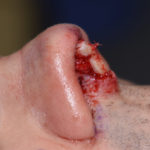One of the three main areas to modify in a rhinoplasty is the nasal tip. The nasal tip is a very elegant structure that has a remarkable amount of anatomical detail from its size, shape, and symmetry of both halves to its amount of projection and its relationship to the nostril and nasal base. The open approach to a rhinoplasty, which is now the standard approach to most rhinoplasties today, has made changing the nasal tip much easier and more reliable than ever before.

While cartilage grafts are used on the bridge of the nose as well in some cases (too build up the bridge), their use in the nasal tip is more common. In the nasal tip, the size of the cartilage graft is much smaller and its shaping and positioning more detailed.
Dr. Barry Eppley
Indianapolis, Indiana


